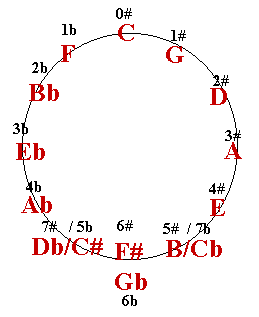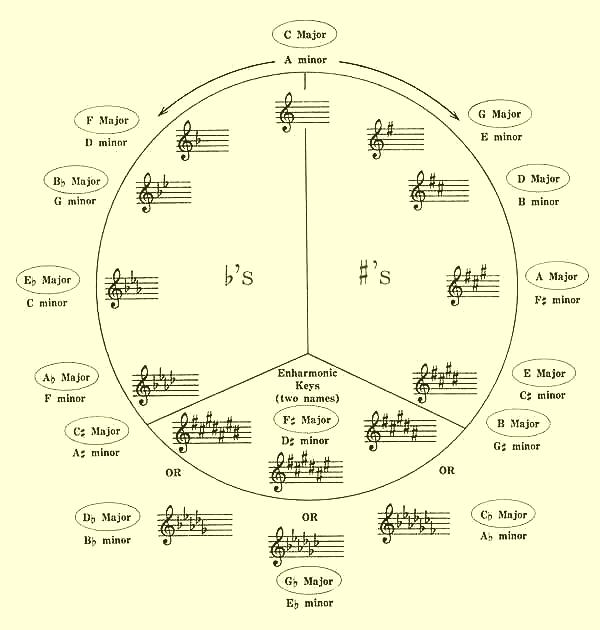The Basics
The circle of fifths is a handy
tool for organizing the 12 possible Major scales into what is called KEY SIGNATURE.
In the Major Scale Lesson, we
learned that "key" refers to the starting note (root) of the scale. "Key
signature" simply refers to the number of sharps or flats that occur in each key. No
two major scales will contain the same number of sharps or flats, so scales can be easily
organized by key signature.
Let's take a look.
As we learned in the Major Scale
Lesson, the C Major scale contains no sharp or flat notes - C D E F G A B. This is the
only Major scale with only natural notes. All other keys will have a varying number of
sharp or flat notes. Each key has a unique key signature.
If we build our next scale
starting with the 5th note of the C major scale, we get the G Major scale - G A B C D E
F#. Notice that the G Major scale has one note that is sharp (F#).
Now, lets build a third scale
starting from the 5th note of the G Major scale. That will give us the D major scale - D E
F# G A B C#. Notice that we now have two notes that are sharp (F# and C#).
If we build a fourth scale from
the 5th note of the D Major scale, we get the A Major scale - A B C# D E F# G#. As you've
probably guessed, the A Major scale has one more sharp than the D Major scale.
That's how it works.
If you build a Major scale from
the 5th note of another Major scale, the new scale will have one more sharp than the scale
you started with.
That's where the "5ths"
in the circle of 5ths comes from, but what about the "circle" part? The circle
comes from the fact that if you continue to build a scale from the 5th note of the
previous scale, you will eventually wind up right back at the beginning, C Major:
G is the 5th note of C Major.
D is the 5th note of G Major.
A is the 5th note of D Major.
E is the 5th note of A Major.
B is the 5th note of E Major.
F# is the 5th note of B Major.
C# is the 5th note of F# Major.
G# is the 5th note of C# Major.
D# is the 5th note of G# Major.
A# is the 5th note of D# Major.
F is the 5th note of A# Major.
C is the 5th note of F Major.
We're right back where we
started, as if we traveled in a circle.
Now, one of the conventions of
key signatures is that a proper key signature does not mix sharps and flats. You have one
or the other, not both. Another convention is that the letter name for each note can only
be used once. These two conventions present us with a problem.
Once you get to a certain point
within the circle, it becomes impossible to observe these two conventions without
considering the note F to be E# and the note C to be B# or resorting to the awkward
designation of DOUBLE SHARP. (Denoted by x, a double sharp note is equivalent to the note
one whole-step higher than the letter name being used. Cx is the same pitch as D.)
Let's look at the key of F#:
F# G# A# B C# D#
E#(F)
In order to avoid using both F
and F# in the key signature, we have to "bend" the rules and name F as E#.
The convention of not using the
same letter name twice is a hold-over from written music notation. Each letter name is
given a line or a space on the staff. It would be very awkward trying to write both F and
F# into the same key signature.
Now, once you get to the key G#
in the circle of fifths, the dreaded double sharp appears:
G# A# B#(C) C# D#
E#(F) Fx(G)
At this point, things are getting
out of hand. So, what would happen if, instead of trying to use a G# scale, we were to use
Ab instead? (Remember that G# and Ab are the same note.)
Let's try it:
Ab Bb C Db Eb F G
Hey, that's a lot better than
that G# monstrosity!
So, let's take a look at key
signatures with flats instead of sharps.
If we go back to the C Major
scale (C D E F G A B), but instead of going to the 5th note, we go to the 4th note to
construct our next scale, we get the F Major scale- F G A Bb C D E. Notice that the key of
F Major has one flat.
If we build our next scale from
the 4th note of the F Major scale, we get the Bb major - Bb C D Eb F G A. Notice that we
now have two flats.
It's the same pattern all over
again.
If you build a Major scale from
the 4th note of another Major scale, the new scale will have one more flat than the scale
you started with.
And once again, if you keep
going, you're going to end up right back at C:
C F Bb Eb Ab Db Gb
B E A D G C
Let's reverse the order of those
notes:
C G D A E B
Gb(F#).....
Hey! Wait a minute! Isn't that
the same order we had before, when we were working the sharps? (Go back and take a look.)
It sure is.
If we take our original circle of
5ths and change each sharp to its flat equivalent we get this:
C G D A E B F#/Gb
Db Ab Eb Bb F C
Now, since we're calling this a
circle, let's look at it that way:

| C |
0# |
|
|
|
|
|
|
|
| G |
1# |
F# |
|
|
|
|
|
|
| D |
2# |
F# |
C# |
|
|
|
|
|
| A |
3# |
F# |
C# |
G# |
|
|
|
|
| E |
4# |
F# |
C# |
G# |
D# |
|
|
|
| B |
5# |
F# |
C# |
G# |
D# |
A# |
|
|
| F# |
6# |
F# |
C# |
G# |
D# |
A# |
E# |
|
| C# |
7# |
F# |
C# |
G# |
D# |
A# |
E# |
B# |
|
| C |
0b |
|
|
|
|
|
|
|
| F |
1b |
Bb |
|
|
|
|
|
|
| Bb |
2b |
Bb |
Eb |
|
|
|
|
|
| Eb |
3b |
Bb |
Eb |
Ab |
|
|
|
|
| Ab |
4b |
Bb |
Eb |
Ab |
Db |
|
|
|
| Db |
5b |
Bb |
Eb |
Ab |
Db |
Gb |
|
|
| Gb |
6b |
Bb |
Eb |
Ab |
Db |
Gb |
Cb |
|
| Cb |
7b |
Bb |
Eb |
Ab |
Db |
Gb |
Cb |
Fb |
|
The Circle of Fifths - Major and
Relative Minor Keys

C is at the 12:00 position,
because the key of C has no sharps or flats.
If you travel clockwise around
the circle to the 6:00 position, each successive key has one more sharp than the preceding
key.
If you travel counterclockwise to
the 6:00 position, each successive key has one more flat than the preceding key. Moving
counterclockwise around the circle is sometimes referred to as the circle of 4ths and also
referred to as "back-cycling" through the circle of 5ths.
Now, let's take a look at F#/Gb:
F# G# A# B C# D#
E#(F)
Gb Ab Bb Cb(B) Db
Eb F
It makes no difference whether
you use sharps of flats with this key. Both give you the same result. If you use sharps,
you end up having to refer to F as E#. If you use flats, you end up having to refer to B
as Cb. It's pretty screwy, but there's nothing to be done about it.
Here's a handy sing-song for
remembering which notes are sharp or flat in each key:
Sharps = Father Charles Goes Down
And Ends Battle.
Flats = Battle Ends And Down Goes
Charles' Father.
Each successive key not only adds
a new sharp or flat, but keeps the sharps or flats that were present in the preceding key.
Moving around the circle
clockwise yields G (Father), D (Father Charles), A (Father Charles Goes) etc... The key of
G has one sharp, which is F. The key of D has two sharps, which are F and C. The key of A
has three sharps, which are F, C and G etc...
Moving around the circle
counterclockwise yields F (Battle), Bb (Battle Ends), Eb (Battle Ends And) etc... The key
of F has one flat, which is B. The key of Bb has two flats, which are B and E. The key of
Eb has three flats, which are B, E, and A etc...
The fingerboard
The circle of 5ths is very easy
to visualize on the fingerboard:

The circle of 4ths
is just as simple:

In each case, you start with C,
and add a sharp or flat for each successive key. It doesn't get much easier, folks.
The circle of fifths falls into
the category of "something handy to know but not something that you can really
practice"... that is, until you begin analyzing songs and/or writing your own songs.
Many common chord progressions follow the circle of 5ths. The more familiar you are with
this device, the easier you will be able to spot it's use within a song.
One use for the circle of 5ths in
a compositional sense is as a key changing device. Changing the key signature in the
middle of a piece of music is called MODULATION. The smoothest modulation occurs between
keys that have only one note difference between the two keys. If you've been paying
attention, you should realize that this is exactly how the keys are organized with the
circle of fifths.
A good way to practice
modulation, utilizing the "circle", is to pick a position on the guitar neck and
"run the scales" through the circle. Without moving up or down the fingerboard
more than one fret, you should be able to pick out each successive sharp or flat key and
play that Major scale.
If you are soloing over a chord
progression that suddenly shifts to a new key, the ability to quickly change to the
appropriate scale is a must. You won't always have the luxury of shifting your hand
position in order to change to a new scale.
Learn your scales.
Learn your fingerboard.
That's the only way
CALL
973-785-0896
tom@newjerseyguitarlessons.com

